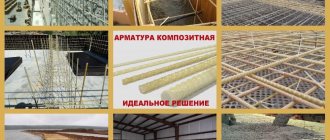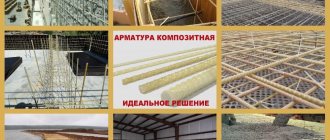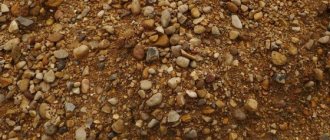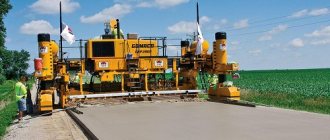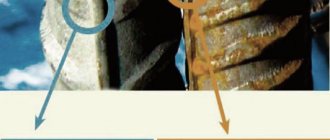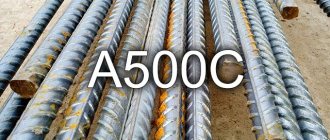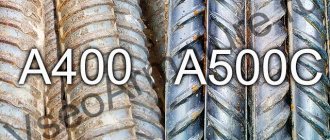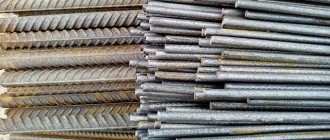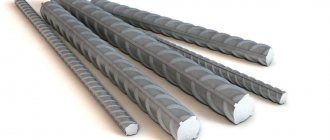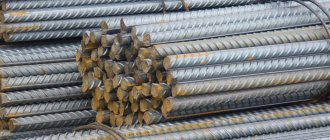Rebar manufacturing technologies
According to the production method, the fittings are:
- Hot rolled rod;
- Cold drawn wire.
In both cases, low-alloy or carbon steel of different grades is used, depending on this, it is divided into 6 classes A-I...A-VI.
The hot production method involves forming a softened steel rod blank using rollers. As the temperature increases, the bonds of the metal structure are strengthened; accordingly, reinforcement made from it is able to withstand greater loads compared to cold-drawn products, and the tensile strength increases.
Cold drawn reinforcement is obtained from an unheated workpiece passing through crimping rollers.
To increase the strength of the reinforcement, it is subjected to heat treatment or galvanizing - the procedure ensures the resistance of the metal to moisture and aggressive environments.
Rod reinforcement with a cross-section of 8 mm or more is produced in individual rods, thin wire reinforcement is produced in coils.
Advantages
The main advantage is that this type of high-quality black metal used, such as 12 mm reinforcement, has the most optimal price in relation to such important criteria as performance characteristics and quality. In this regard, this particular reinforcing steel is one of the most popular and most widespread types of products. Among other advantages we highlight:
- high level of ductility, flexibility, as well as strength characteristics;
- excellent resistance to various types of influences, including thermal, mechanical, and chemical;
- possibility of use in the construction of stressed structures made of reinforced concrete;
- good anti-corrosion characteristics;
- Possibility of use in structures with both mechanical and welded types of connection.
In the event that 12 mm reinforcement is required, we offer this type of graded black metal. The sale of reinforcing steel is one of the basic areas of commercial activity of our company, which closely cooperates with leading domestic manufacturers, the quality of their products has been proven by time and successful use at facilities for various functional purposes. In this regard, if you need guaranteed quality and optimal price per ton, contact us! We will be glad to see you among our regular customers.
Classification and marking of fittings
The classification of reinforcement involves dividing products according to the class of steel used for the production of rods. The division is regulated by GOST 5781-82 “Hot-rolled steel for reinforcement of reinforced concrete structures”:
| Class, old designation | Class, new designation | Profile type | Rod color designation |
| A.I. | A240 | Smooth | — |
| A-II | A300 | Periodic* | |
| A-III | A400 | ||
| A-IV | A600 | Red | |
| AV | A800 | Red and green | |
| A-VI | A1000 | Red and blue |
*by agreement with the customer, A-II...AV steel can be manufactured with a smooth profile.
Classes, in turn, are divided into subclasses, which are designated by additional indices:
- “C” is a rod steel that is suitable for welding;
- “T” - heat-treated product;
- “K” - corrosion-resistant steel, i.e. treated with zinc;
- "SK" is a corrosion-resistant steel that can be welded.
Metal fittings of different classes are made from various steel alloys, which determine its technical properties. In this case, the diameter of the rods is taken into account:
| Reinforcing steel class | steel grade | Profile diameter, mm |
| A-I (A240) | StZkp, StZps, StZsp | 6…40 |
| A-II (A300) | St5sp, St5ps 18G2S | 10…40 40…80 |
| Ac-II (Ac300) | 10GT | 10…32 (36…40) |
| A-III (A400) | 35GS, 25G2S 32G2Rps | 6…40 6…22 |
| A-IV (A600) | 80C | 10…18 (6…8) |
| 20ХГ2Ц | 10…32 (36…40) | |
| AV (A800) | 23Х2Г2Т | (6-8) 10…32 (36…40) |
| A-VI (A1000) | 22Kh2G2AYu, 22Kh2G2R, 20Kh2G2SR | 10…22 |
The table is compiled according to GOST 5781-82.
Read on to find out more!
How to replace a vibrator for concrete
Concrete: properties, types and applications
Two of the best concrete mix recipes
Vertical concrete placement technique
Protective layer of concrete for reinforcement
Concrete grade for strip foundation
- 2.45
Rating: 2.5 out of 5 Votes: 203
- 4
Reply
6 years ago
6 years ago
deleted 6 years ago
Igor
6 years ago
Quote
For the manufacture of reinforcement frames for monolithic reinforced concrete structures, we always use smooth reinforcing steel, class A240, and periodic profile A400 and A500. When purchasing reinforcement, we always take a certificate for this product from the trading organization, which indicates all the characteristics of the reinforcing steel and its compliance with GOST. In frames, reinforcing steel is connected by electric welding or binding wire, depending on how specified in the project.
Egor
6 years ago
Quote
For pouring into concrete, there is no need to take reinforcement with increased corrosion resistance; concrete itself acts as a reliable means of protecting the reinforcement. Sometimes it is generally better to use metal shavings as a reinforcing component or polypropylene fiber.
Hope
6 years ago
Quote
If you know exactly for what purposes you are going to use the fittings, and also knowing some of its characteristics, it will be easier for you to make a choice when purchasing. According to the characteristics, A400 reinforcement is suitable for building cottages, strengthening road surfaces, and reinforcing floors or walls. It is divided into several categories. Additional indices indicate a certain type of reinforcement: “K” - anti-corrosion, “C” - weldable, “T” - heat-strengthened. Pay attention to the pattern of the reinforcement rib. Reinforcement with a ring pattern is better suited for more massive concrete structures. And with a crescent pattern, it is excellent for thin-walled construction.
Mechanical properties of reinforcing steel
Bar reinforcement of different brands has individual mechanical properties, which are taken into account when choosing a product for reinforcing concrete structures. The main ones are given in table No. 8 GOST 5781-82:
| Reinforcing steel class | Yield strength st | Temporary tensile strength sв | Relates. elongation d5,% | Uniform elongation dr, % | Impact strength at -60 °C | Bending and cold testing, where c is the thickness of the post, d is the diameter of the rod | |||
| N/mm2 | kgf/mm2 | N/mm2 | kgf/mm2 | MJ/m2 | kgf×m/cm2 | ||||
| AI (A240) | 235 | 24 | 373 | 38 | 25 | — | — | — | 180°; c = d |
| A-II (A300) | 295 | 30 | 490 | 50 | 19 | — | — | — | 180°; c = 3d |
| Ac-II(Ac300) | 295 | 30 | 441 | 45 | 25 | — | 0,5 | 5 | 180°; c = d |
| A-III(A400) | 390 | 40 | 590 | 60 | 14 | — | — | — | 90°; c = 3d |
| A-IV(A600) | 590 | 60 | 883 | 90 | 6 | 2 | — | — | 45°; c = 5d |
| AV (A800) | 785 | 80 | 1030 | 105 | 7 | 2 | — | — | 45°; c = 5d |
| A-VI (A1000) | 980 | 100 | 1230 | 125 | 6 | 2 | — | — | 45°; c = 5d |
The properties of the reinforcement bars are determined by laboratory tests, based on the results of which a protocol is drawn up. Deviation from GOST rules is allowed in agreement with the customer.
Reinforcement cross-sectional area table
When calculating reinforcing rods, in addition to the diameter, the mass of the products is also taken into account. It is given in the assortment GOST 5781-82:
| Nominal rod diameter, mm | Cross-sectional area, cm2 | Average* weight of 1 m profile |
| 6 | 0,283 | 0,222 |
| 8 | 0,503 | 0,395 |
| 10 | 0,785 | 0,617 |
| 12 | 1,131 | 0,888 |
| 14 | 1,54 | 1,21 |
| 16 | 2,01 | 1,58 |
| 18 | 2,54 | 2 |
| 20 | 3,14 | 2,47 |
| 22 | 3,8 | 2,98 |
| 25 | 4,91 | 3,85 |
| 28 | 6,16 | 4,83 |
| 32 | 8,01 | 6,31 |
| 36 | 10,18 | 7,99 |
| 40 | 12,57 | 9,87 |
| 45 | 15,00 | 12,48 |
| 50 | 19,63 | 15,41 |
| 55 | 23,76 | 18,65 |
| 60 | 28,27 | 22,19 |
| 70 | 38,48 | 30,21 |
| 80 | 50,27 | 39,46 |
*weight is given as an average value - a more accurate parameter depends on the specific grade used for the production of rolled steel bars.
TEST METHODS
4. 1. Chemical analysis of steel is carried out according to GOST 12344-88, GOST 12348-78, GOST 12350-78, GOST 12352-81, GOST 12355-78, GOST 12356-81, GOST 18895-81 or other methods that ensure the required accuracy . 4. 2. The diameter and ovality of the profiles are measured at a distance of at least 150 mm from the end of the rod or at a distance of no less than 1500 mm from the end of the skein with a skein weight of up to 250 kg and at least 3000 mm with a skein weight of more than 250 kg. 4. 3. Dimensions are checked with a measuring tool of the required accuracy. 4. 4. One sample is cut from each selected rod for testing tensile, bending and impact strength. 4.5. Sampling for testing tensile, bending and impact strength is carried out in accordance with GOST 7564-73 4.6. The tensile test is carried out according to GOST 12004-81. 4.7. The bending test is carried out in accordance with GOST 14019-80 on samples with a cross-section equal to the cross-section of the rod. For rods with a diameter of over 40 mm, it is allowed to test samples cut along the axis of the rod on a mandrel with a diameter reduced by half compared to that indicated in the table. 4, with bending force applied from the side of the cut. 4.8. Determination of impact strength is carried out according to GOST 9454-78 on samples with a concentrator type U type 3 for rods with a diameter of 12-14 mm and samples of type 1 for rods with a diameter of 16 mm or more. Samples are manufactured in accordance with the requirements of GOST 9454-78. 4.9. It is allowed to use statistical and non-destructive methods for monitoring the mechanical properties and mass of profiles. 4.10. The curvature of the rods is measured along the length of the supplied profile, but not shorter than 1 m. 4.11. Determination of statistical indicators of mechanical properties in accordance with mandatory Appendix 2. 4.12. The quality of the surface is checked without the use of magnifying devices. 4.10—4.12. (Introduced additionally, Amendment No. 3). 4.13. The height of the transverse projections of a periodic profile should be measured along the vertical axis of the cross-section of the reinforcing bars. (Introduced additionally, Amendment No. 4).
Areas of application of steel reinforcement
The characteristics of steel reinforcement determine the scope of its application. Smooth profile rods are used:
- For dressing the working rods of the frame;
- Knitting of decorative items for design;
- Installation of individual elements of complex mechanisms.
Periodic profile bars are more in demand:
- Strengthening concrete structures in areas of greatest tension and compression;
- Installation of supporting elements and structures;
- Reinforcement of plaster layers, floor screeds;
- Construction of road surfaces and sidewalk areas;
- Installation of reinforcing belts for laying blocks and bricks.
The main purpose of bar reinforcement with a periodic profile is to strengthen concrete structures. Their rods are knitted into flat or spatial frames. The fittings in them perform different functions:
- Compensation for concrete fracture by creating tensile stress on the rod. Maximum loads are concentrated in the lower part of beam-type structures on two supports or with rigid pinching;
- Compensation for compression that is concentrated in the upper part of the same beam.
Directions for use
Fittings ø12 mm are widely used for:
- strengthening of reinforced concrete structures, including prefabricated reinforced concrete, which are produced in production conditions, and monolithic reinforced concrete, erected directly at the construction site;
- reducing the likelihood of the formation of various types of deformation of reinforced concrete structures, including inclined cracks;
- formation of frame structures for various functional purposes, capable of withstanding high loads, including tensile, compressive, and torsional loads.
These are just the main areas of use of this type of reinforcing steel. You can buy fittings 12 for a wide range of other purposes. More detailed information can be obtained from our specialists, as well as making a purchase.
Flaws
Bar reinforcement has several disadvantages that need to be taken into account:
- In the absence of an anti-corrosion coating, the rods are subject to oxidation upon contact with water. Processes can even begin from exposure to water in the cement during its hardening.
- Inability to perform functions with rod products if the rod class and its diameter are incorrectly selected.
- Excessively stressed reinforcement can have the opposite effect and form cracks in the concrete structure.
- A protective layer of concrete is required - at least 2 diameters of the section size to prevent water from entering the rods.
Set of requirements
Since we promised, we’ll tell you about another important parameter that needs to be taken into account when buying the type of fittings in question. It can be manufactured with so-called standard and additional requirements. For example, fittings 12 A500C with additional requirements, and 12 A500 with standard ones. We hope you caught the difference? Yes, indeed, there is an index after the yield point. It is he who indicates the presence of additional requirements, their characteristics; we will briefly indicate the main ones:
- C – welded, such rolled products can be easily welded, without certain conditions and the use of specific types of welding;
- K – with a high degree of resistance to so-called corrosion cracking;
- plasticity, its categories (for example, H or E);
- the degree of resistance to repeatedly repeated, so-called cyclic loads, when it is increased, the product has the index “U”;
- resistant to spontaneous changes in stress in parts pre-loaded during constant volumetric deformation, is marked with the index “P”.
The scope of application and installation technology depend on the presence or absence of additional requirements and their specificity. Among other things, these parameters predetermine the structural features of the object being built and its elements.
Main categories
The following classes of fittings are popular in Russia: A240, A400, A500C, AT800. Below we will look at them in detail.
A240 (AI)
Reinforcement of this type is made from carbon steels, which additionally contain small amounts of manganese, nickel, chromium, and copper. Brand A240 - smooth fittings. If the cross-sectional diameter is less than 12 millimeters, then A240 can be in the form of large coils held together with wire. Spare parts with a diameter of more than 12 millimeters are made in the form of separate rods of short length (up to 5 meters). The brand is used for the construction of small lightweight structures. It can also be used to reinforce small objects - compact columns, curbs, partitions, walls.
A400 (A-III)
A400 class rods have a round cross-section with a corrugated surface. Corrugation on spare parts appears due to small protrusions, which are located at an angle of 40-45 degrees relative to the central axis of the reinforcement. A400 is made from carbon steel, which includes a large number of filler components. The main additive component is manganese, which makes the alloy more durable and reliable. In addition to manganese, the alloy also includes other components - chromium, nickel, copper. The presence of stiffening ribs provides better adhesion of the A400 to the concrete composition.
Therefore, durable composite parts based on reinforced concrete are often made from the A400 brand - walls, floors, ceilings, inclined surfaces, vertical pillars, beams, bridges. Another area of application is road pavement reinforcement. Welding can be used to connect A400 parts to each other, but it is recommended to do butt welding using the butt welding method or using spot welding machines. Alternative welding technologies are less reliable, and the resulting structure will have low bending strength. This negatively affects the shelf life of the reinforced concrete product.
A500C
The A500C brand appeared on the Russian market relatively recently - in the 90s. Reinforcement of this type undergoes a number of auxiliary technological treatments (hot rolling, thermal hardening). These treatments significantly increase the physical properties of the material - elasticity, strength, stretching. Also, the A500C brand has poor contact with water and air, since it is chemically inert. Interestingly, grade A500C is smelted from ordinary steel containing an average amount of carbon and a minimum amount of alloying additives.
This makes the material cheaper to produce, which will be very useful for the builder. The A500C brand tolerates welding well, and can be joined using almost any welding method - overlap, butt, cross-overlay, and so on. The brand can be used for the construction of both large and small buildings based on concrete. These can be elements of a house or the entire house, bridges, hanging structures, medium-sized hangars, support poles, power lines. The only major drawback of the A500C is the deterioration of physical properties at low temperatures (below -30 degrees). Therefore, parts of this type are not recommended for use in the Far North.
AT800
The AT800 brand belongs to the class of heavy-duty reinforcements that have undergone hot rolling and thermomechanical hardening. The surface of the material is usually corrugated, although smooth varieties of the AT800 brand are also available. The brand is used for the construction of large massive structures based on reinforced concrete. These can be multi-story buildings, bridges, hangars, and so on. Thermo-mechanical hardening performs the following functions:
- Increasing ductility while maintaining the strength of the material (ductility increases by 20-30%).
- Increased fatigue strength, which allows spare parts to retain their shape even during long-term use.
- Improving anti-corrosion properties, minimizing the risk of cracking of the material upon contact with chemicals.
A little about decoding steel
For the manufacture of different fittings, different types of steel are used:
- Alloyed (with impurities of other metals);
- Carbon (its strength characteristics are determined by the amount of this chemical).
Carbon steel is marked as St with digital indices from 0 to 6. This value hides the average amount of carbon in the alloy as a percentage. The higher the value, the stronger and less flexible the rod.
St3...St4 can have different degrees of deoxidation:
- Boiling (“kp”);
- Semi-calm (“dog”);
- Calm (“sp”)
St5-St6 are produced:
- Semi-calm;
- Calm.
Various chemical elements are added to alloy steels, which affect different properties of the alloy:
| Element | Designation in steel grade | Tensile strength | Yield strength | Relative extension | Hardness | Impact strength | Fatigue strength | Weldability | Corrosion resistance | Cold resistance | Red brittleness |
| Carbon | U | ++ | + | = | ++ | — | — | — | |||
| Manganese | G | + | + | — | + | — | + | + | |||
| Silicon | WITH | + | + | — | + | = | — | — | |||
| Nickel | N | + | + | + | + | + | ++ | ||||
| Chromium | X | + | + | — | ++ | — | ++ | ||||
| Copper | D | ++ | |||||||||
| Niobium | B | ++ | ++ | — | + | + | + | ||||
| Vanadium | F | + | + | — | + | ++ | + | + | |||
| Vanadium nitride | AF | ++ | ++ | — | + | + | + | ||||
| Molybdenum | M | + | + | — | + | ++ | + | + | |||
| Bor | R | ++ | ++ | — | + | — | + | + | |||
| Titanium | T | + | + | + | — | + | |||||
| Aluminum | YU | — | |||||||||
| Sulfur | No | — | — | — | — | — | = | ++ | |||
| Phosphorus | P | + | + | = | + | = | = | — | = | ||
| Arsenic | No | — | — | — | — | — | — | ||||
| Nitrogen | A | ++ | ++ | = | ++ | = | — | — | |||
| Oxygen | No | = | = | = | + | = | = | = | — | — | + |
Designations in the table: (+) - increases; (++) - significantly increases; (-) - reduces; (=) - significantly reduces; (0) - does not have a noticeable effect.
The marking of construction reinforcement made of alloy steel 22Х2Г2Р, from which products of class A1000 are produced, is deciphered as follows:
- 22Х – 0.22% chromium;
- 2G – manganese 0.02%;
- 2P – boron 0.02%.
The remaining volume is iron (Fe).

